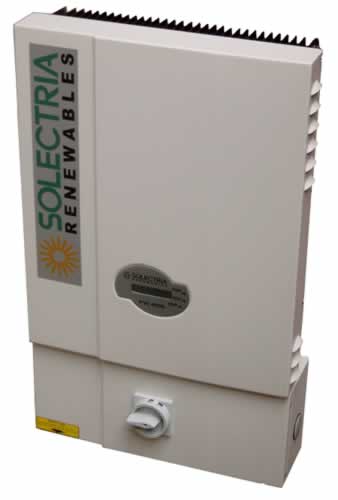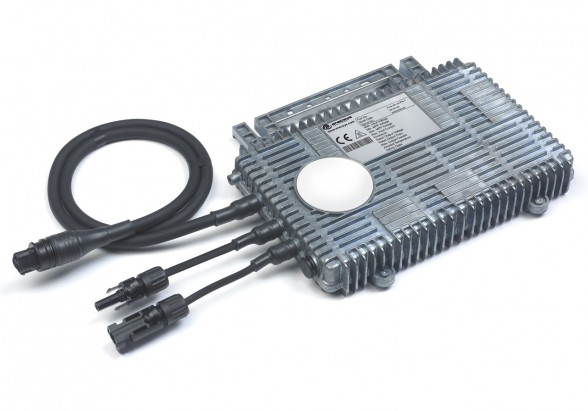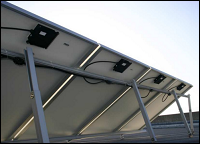 Traditional String Inverter Systems
Traditional String Inverter SystemsSolar panels produce DC current at a voltage and amperage that depends on the module's design and the outside conditions, such as weather, positioning, and orientation.
The main problem with traditional string inverter systems is that the string of panels will act as if they are all one large panel, but who's peak production is only going to be as high as the lowest producing panel. For example, if a panel has a slight, 5% higher resistence due to a minor manufacturing defect, the entire string will perform 5% worse. This issue is also dynamic, meaning that if one panel became shaded in the string, this would reduce the entire string's output dramatically even though the other panels are not shaded.
A solution to this issue is employing the use of micro inverters.
 Solar Micro Inverters are very small inverters designed to handle the output of a single solar pv panel. This avoids the issues usually associated with string inverters, as micro inverters serve to isolate each solar panel from each other.
Solar Micro Inverters are very small inverters designed to handle the output of a single solar pv panel. This avoids the issues usually associated with string inverters, as micro inverters serve to isolate each solar panel from each other.
This means that any factors that affect a panels performance would have no effect on the other panels in the string. For example, if one panel were to become shaded, only the panel(s) being shaded would be affected - the rest of the system would not be affected.
The main disadvantages of micro inverters is time and cost. With a string inverter, an installer would install the panels, wire them, and then run the wire to the central inverter. With micro inverters, each module must be installed, and then the micro inventers must be installed and wired to each individual module. Then the micro inverters must be wired to a trunk cable, and then run to the junction box.
 The SPP AC PV Module is a module that combines the PV module and the micro inverter during the manufacturing process. In traditional micro inverter applications, the micro inverter is attached to the junction box on the back of the panel. With this solution, the micro inverter replaces the junction box on the PV module completely. This means you have all the advantages of micro inverters, and none of the disadvantages.
The SPP AC PV Module is a module that combines the PV module and the micro inverter during the manufacturing process. In traditional micro inverter applications, the micro inverter is attached to the junction box on the back of the panel. With this solution, the micro inverter replaces the junction box on the PV module completely. This means you have all the advantages of micro inverters, and none of the disadvantages.
With this AC Module, you never have to purchase or supply an inverter. This means no sizing calculations, no seperate shipments or costs - everything is already included in the AC Module.
Since PV modules naturally vary in voltage, current, and wattage. In traditional PV systems, modules are wired together in series and then connected to a central inverter. This inverter optimizes the performance of the entire group of PV modules, but the modules individually will not be at their optimal performance. With the Solar Panels Plus AC module, the inverter is built into the module itself. This means that each module individually operates at it’s optimal power output, maximizing it’s power output and eliminating the losses previously mentioned.
A new technology employed in this system is one that makes handling the modules safer than ever before. Using smart-grid programming, the integrated micro inverters produce no power until they are connected to the grid with a stable electrical connection for 5 minutes.
This means that while handling the modules, making electrical connections from module to module, and during the bulk of the installation process, you are completely safe from electrical shock.
The new AC module makes installation simpler than ever before. These systems come prepackaged with racking, wiring, and the AC module itself, allowing for a fast, clean, simple installation.
There are now only two basic installation steps – anchor the modules to the roof, and run a dedicated circuit to the roof. This makes design easy, installation simple, and keeps the system costs down, making it even more affordable for your home or business.
Lifespan, durability, and reliability of a PV system is one of most important attributes to consider. Traditional central inverters have a life expectancy of 12 to 15 years. Because micro-inverters are less accessible than a central inverter, and are subject to more extreme thermal conditions, they are held to a much higher standard of reliability and durability. Micro-inverters that are built into PV modules will often last just as long as the module itself – 25 to 30 years, or longer.
In a typical PV system, if a module – or the central inverter – encounters a problem or is damaged, the entire system suffers power losses, or is shut down completely. With the AC module, this is no longer an issue. If one module is damaged or encounters an issue, the remainder of the system continues to operate at peak performance. This greatly improves the reliability of the PV system.